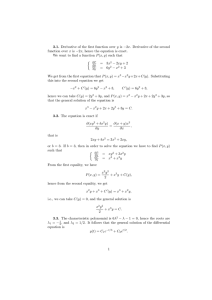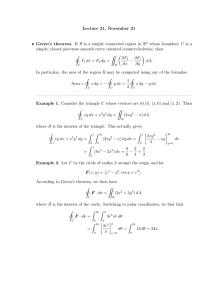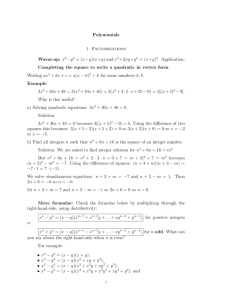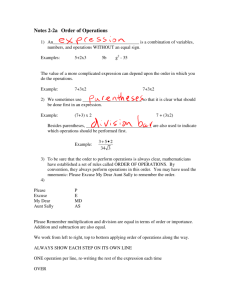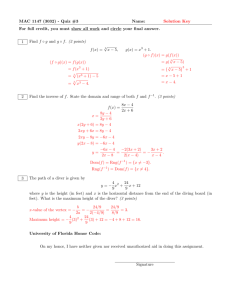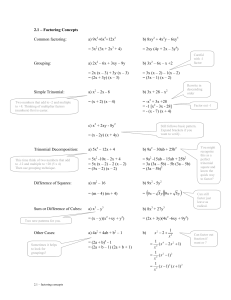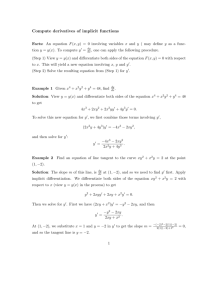Math 211-330/332 Worksheet 2 Jan 25, 2016 Solutions Review
advertisement
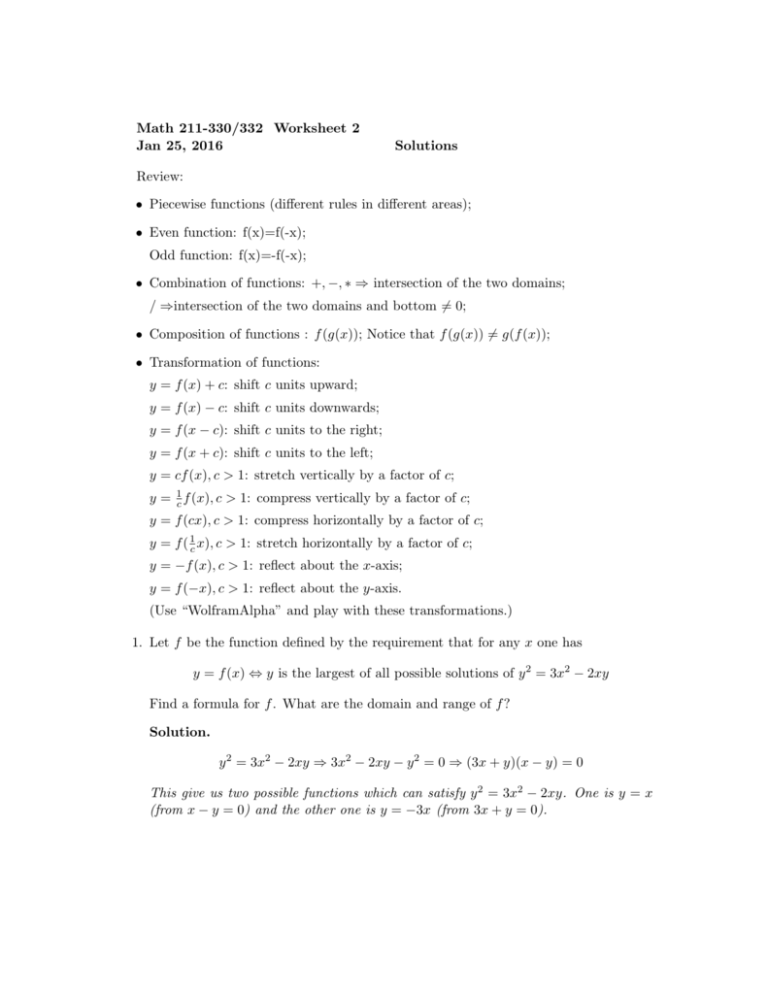
Math 211-330/332 Worksheet 2 Jan 25, 2016 Solutions Review: • Piecewise functions (different rules in different areas); • Even function: f(x)=f(-x); Odd function: f(x)=-f(-x); • Combination of functions: +, −, ∗ ⇒ intersection of the two domains; / ⇒intersection of the two domains and bottom 6= 0; • Composition of functions : f (g(x)); Notice that f (g(x)) 6= g(f (x)); • Transformation of functions: y = f (x) + c: shift c units upward; y = f (x) − c: shift c units downwards; y = f (x − c): shift c units to the right; y = f (x + c): shift c units to the left; y = cf (x), c > 1: stretch vertically by a factor of c; y = 1c f (x), c > 1: compress vertically by a factor of c; y = f (cx), c > 1: compress horizontally by a factor of c; y = f ( 1c x), c > 1: stretch horizontally by a factor of c; y = −f (x), c > 1: reflect about the x-axis; y = f (−x), c > 1: reflect about the y-axis. (Use “WolframAlpha” and play with these transformations.) 1. Let f be the function defined by the requirement that for any x one has y = f (x) ⇔ y is the largest of all possible solutions of y 2 = 3x2 − 2xy Find a formula for f . What are the domain and range of f ? Solution. y 2 = 3x2 − 2xy ⇒ 3x2 − 2xy − y 2 = 0 ⇒ (3x + y)(x − y) = 0 This give us two possible functions which can satisfy y 2 = 3x2 − 2xy. One is y = x (from x − y = 0) and the other one is y = −3x (from 3x + y = 0). From the graph of the two functions, we can see that on (−∞, 0), the red one is larger than the blue one; on (0, +∞), the blue one is larger than the red one. So we combine these two into a new piecewise function defined by ( y= (red) − 3x x ∈ (−∞, 0) (blue)x x ∈ [0, +∞) We can check that this function satisfy the condition y 2 = 3x2 − 2xy. The domain is (−∞, +∞) and the range is [0, +∞). 2. Determine whether f is even, odd, or neither. (a). f (x) = (b).f (x) = (c).f (x) = x x2 +1 x2 x4 +1 x x+1 Solution. (a). f (−x) = (b).f (−x) = (−x)2 (−x)4 +1 (c). f (−x) = −x −x+1 = −x (−x)2 +1 x2 x4 +1 = − x2x+1 = −f (x) ⇒ odd function; = f (x) ⇒ even function; ⇒ neither odd function nor even function. 1 3. If f (x) = x−1 , g(x) = and the domains. √ −x2 − x, write a formula for each of the following functions (a). A(x) = f (x) + g(x); (b).B(x) = f (x) − g(x); (c). C(x) = f (x)g(x); (d). D(x) = f (x) g(x) . Solution. Domain for f (x) is x 6= 1, domain for g(x) is −1 ≤ x ≤ 0. √ 1 (a).A(x) = x−1 + −x2 − x, domain: −1 ≤ x ≤ 0; √ 1 (b).B(x) = x−1 − −x2 − x, domain: −1 ≤ x ≤ 0; √ (c).C(x) = (d).D(x) = −x2 −x x−1 , domain: −1 ≤ x ≤ 0; √1 , domain: −1 < x (x−1) −x2 −x < 0. 4. A function f is given that satisfies f (x + 3) = x2 for all real numbers x. Compute (a).f (0) (b).f (3) (c).f (π) (d).f (t) (e).f (x) (f).f (f (2)) (g).f (2f (x)). Solution. (a). Let x + 3 = 0 so that the left hand side becomes f (0). Then we solve out x = −3, plug in the right hand side. Now we have f (0) = (−3)2 = 9. It’s OK to do (a) (b) (c) in this way. But we will get trouble for the rest. So my suggestion to solve this kind of sequence problem: Think of f (g(x)), figure out what is g(x) and what is f (t). Step 1: Let t = g(x) = x + 3. So we can get f (t) on the left hand side instead of f (x + 3); Step 2: Represent x by t. From Step 1, we have t = x + 3 ⇒ x = t − 3; Step 3: Plug the representation of x in the right hand side. Then we have f (t) = f (x + 3) = x2 = (t − 3)2 ⇒ f (t) = (t − 3)2 We know the fact that f (t) = (t − 3)2 is the same thing as f (x) = (x − 3)2 . Now (a),(b),(c),(d),(e) becomes trivial. (Just plug in.) (f ) f (2) = (2 − 3)2 = 1 f (f (2)) = f (1) = (1 − 3)2 = 4 (g) f (x) = (x − 3)2 2f (x) = 2(x − 3)2 f (2f (x)) = f (2(x − 3)2 ) = (2(x − 3)2 − 3)2 Remark: we can also relate this with function transformation.
